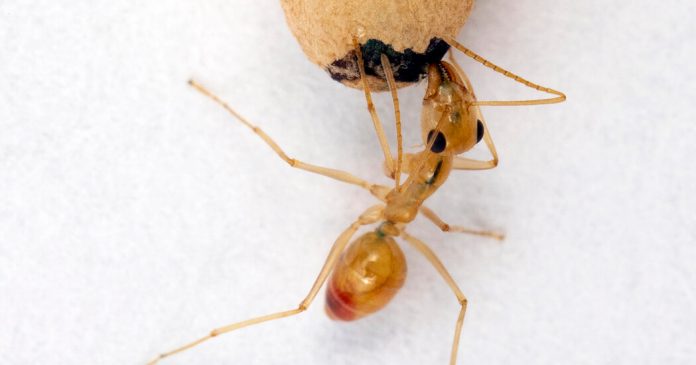Orli Snir, a biologist on the Rockefeller College in New York, couldn’t maintain her ants alive. She had plucked pupae from a colony of clonal raider ants, the place the sesame seed-size offspring that regarded like puffed rice cereal have been being fussed over by each youthful larvae and older grownup ants. Then she had remoted every pupa right into a tiny, dry check tube. And each time, they drowned.
Extra particularly, every pupa was leaking a lot watery, golden-tinted fluid it was struggling to breathe. However they lived when Dr. Snir whisked the fluid away with a capillary tube. Her humble remark led down an odd path of experiments towards a weird however inescapable conclusion: This mysterious ant goo features rather a lot like milk.
Not only one ant species makes use of this milk, both. Maybe all ants do, in response to a paper led by Dr. Snir that was printed Wednesday within the journal Nature. It provides ants amongst different surprising creatures like pigeons, spiders and beetles that feed one another milk-like fluids. And very similar to milk in mammals, it knits collectively ants of various generations — and the bigger ant society, too.
After first noticing the unusual secretions, Dr. Snir scanned via the scientific literature and it appeared that her ant pupae have been oozing one thing that was principally unknown to science. She shared what she had discovered along with her co-author, Daniel Kronauer who leads a analysis group on ant evolution at Rockefeller. “My first thought was, ‘That is loopy,’” he stated.
Within the conventional view, ant pupae are passive, trapped in a boring, transitional section of life. The insect begins as a wriggling, wormlike larva, then seals itself into an inert pupa that appears like a residing sleeping bag, rising as a full-grown grownup. Inside a residing colony, the place these three phases are in a hubbub of fixed, inscrutable contact, pupae appear to remain dry.
So the place does this pupae juice usually go? To seek out out, Dr. Snir added blue meals coloring to pupae shells. Then she put them again into an ant colony, the place pupae are saved in a slimy heap oddly paying homage to risotto. Inside hours, she discovered, grownup ants and larvae took on a blue tint, an indication that each teams siphon away the fluid. Grownup ants even appear to choose up larvae and put them on prime of pupae in order that colony’s youngest members can slurp up the secretions.
The workforce’s additional experiments uncovered an internet of codependent relationships. If grownup ants don’t lick off the pupal fluid, the pupae drown or die of fungal infections. And if newly hatched larvae don’t get to drink it, they’re much less more likely to survive. As for what the adults get for consuming the stuff themselves, that’s nonetheless unclear, however early research present it incorporates hormones and neuroactive compounds.
Then the workforce checked out pupae from 4 different ant species from throughout the ant tree of life. Every of those species appeared to have an analogous fluid, suggesting the newly acknowledged “milk” is frequent amongst ants.
“I’m completely enthusiastic about this work, which I think about essential,” stated Bert Hölldobler, an ant biologist at Arizona State College who didn’t take part within the analysis. In 1977, Dr. Hölldobler added, he printed an remark that grownup ants gravitated to chemical compounds on the pores and skin of pupae, however he hadn’t taken the subject any additional.
The invention that intergenerational ant interactions revolve across the sharing of “ant milk” may additionally hook up with deeper riddles.
One is how ants grew to become so social within the first place. On condition that utilizing pupal liquid includes getting into a covenant of codependency — pupae have to be cleaned of it and larvae should feed on it, or they die — this “milk” may be the adaptation that first sure solitary-living ants into colonies.
It additionally could be the glue that binds present-day ant societies collectively, performing like a communal endocrine system for the colony to swap the hormones that form its future growth. “I feel we’ll see much more research constructing off what was found right here,” stated Adrian Smith, one other biologist exterior the analysis workforce on the North Carolina Museum of Pure Sciences.
However one ultimate, urgent query stays unanswered. “I’ll say I did attempt to style it,” Dr. Snir stated. She thought the ant milk was faintly sugary, however in hindsight she’s unsure if that was simply because she anticipated it to be. She even requested her lab mates for a second opinion. “That is the reality: I used to be on the lookout for volunteers, and no one agreed to style it,” she stated.
“I’m nonetheless wanting.”


